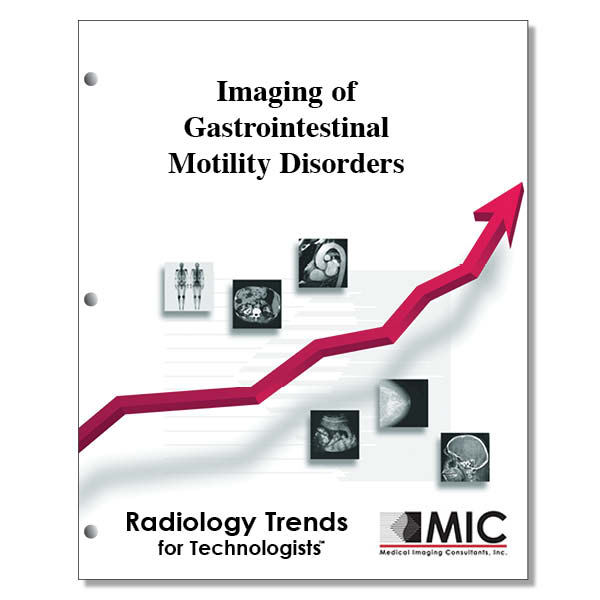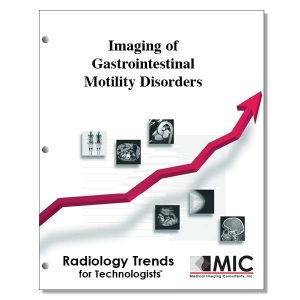

Imaging of Gastrointestinal Motility Disorders
Common tests used to evaluate and diagnose gastrointestinal motility disorders are discussed, and findings of common motility disorders throughout the gastrointestinal tract are described.
Course ID: Q00787 Category: Radiology Trends for Technologists Modalities: CT, MRI, Nuclear Medicine, Radiography, RRA2.75 |
Satisfaction Guarantee |
$29.00
- Targeted CE
- Outline
- Objectives
Targeted CE per ARRT’s Discipline, Category, and Subcategory classification:
[Note: Discipline-specific Targeted CE credits may be less than the total Category A credits approved for this course.]
Computed Tomography: 2.00
Procedures: 2.00
Abdomen and Pelvis: 2.00
Magnetic Resonance Imaging: 2.00
Procedures: 2.00
Body: 2.00
Nuclear Medicine Technology: 2.00
Procedures: 2.00
Gastrointestinal and Genitourinary Procedures: 2.00
Radiography: 2.00
Procedures: 2.00
Thorax and Abdomen Procedures: 2.00
Registered Radiologist Assistant: 2.75
Procedures: 2.75
Abdominal Section: 2.75
Outline
- Introduction
- Gastric-Emptying Scintigraphy
- Small-Bowel Scintigraphy
- Colon Scintigraphy
- Gastric Accommodation Testing
- Esophagography
- Upper Gastrointestinal Series
- Small-Bowel Follow-through Study
- Radiopaque Marker Study
- Defecography
- Cine MR Enterography
- Computed Tomography
- Manometry
- Small-Bowel Manometry
- Anorectal Manometry
- Achalasia
- Esophagogastric Junction Outflow Obstruction
- Scleroderma
- Distal Esophageal Spasm
- Hypercontractile Esophagus
- Postsurgical Dysmotility
- Gastroparesis
- Rumination Syndrome
- Cannabis-Induced Gastroparesis
- Impaired Gastric Accommodation
- Chronic Intestinal Pseudo-Obstruction
- Scleroderma
- Amyloidosis
- Enteric Visceral Myopathy
- Opioid-Induced Hypomotility
- Constipation and Colonic Inertia
- Acute Colonic Pseudo-Obstruction
- Hirschsprung Disease
- Pelvic Floor Dysfunction
Objectives
Upon completion of this course, students will:
- be familiar with the function of the submucosal plexus within the enteric nervous system
- be familiar with the primary source of gastrointestinal motility disorders
- identify the nonspecific symptoms associated with gastrointestinal motility disorders
- identify the criteria for determining delayed gastric emptying standards
- be familiar with the use of Indium 111 charcoal particles
- be familiar with the normal values for a gastric emptying scintigraphy
- be familiar with the imaging technique used for gastric accommodation diagnosis
- be familiar with the primary purpose of esophagography in the evaluation of patients with dysphagia
- recognize the position typically used to observe esophageal motility during esophagography
- be familiar with the primary purpose of performing an upper gastrointestinal series
- identify the positioning of the patients during defecography for the injection of barium into the rectum
- be familiar with the physiological changes associated with the pelvic floor during defecography
- understand the role catheter-based manometry plays in the assessment of small bowel motility patterns
- be familiar with the characteristic findings observed in barium esophagography for patient with achalasia
- identify the diagnostic tool instrumental in confirming the diagnosis of achalasia
- be familiar with the subtypes of achalasia
- be familiar with the postoperative changes leading to EGJOO
- be familiar with how the diagnosis of EGJOO is obtained
- identify the subtypes of scleroderma
- be familiar with the treatment for patients with scleroderma
- be familiar with the manometric characteristics in hypercontractile esophagus
- be familiar with the role of phasic contraction in the gastric antrum
- be familiar with the behavioral techniques for treating rumination syndrome
- recognize the potential effects of cannabinoids on the stomach
- identify the cells responsible for pacemaker activity in gastrointestinal motility
- be familiar with the part of the gastrointestinal tract primarily involved in CIPO
- be familiar with the dysmotility associated with scleroderma
- identify the diagnostic procedure required to confirm gastrointestinal amyloidosis
- be familiar with the primary components involved in coordinated defecation
- be familiar with the purpose of fluoroscopic contrast enema examination for constipation
- identify the diagnostic testing necessary for differentiating pseudo-obstruction from mechanical obstruction
- identify the portion of the colon predominately affected in Hirschsprung disease
- identify the diagnostic tests used to diagnose dyssynergic dysfunction
